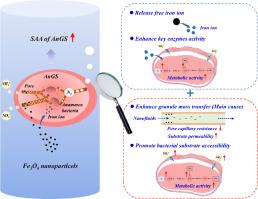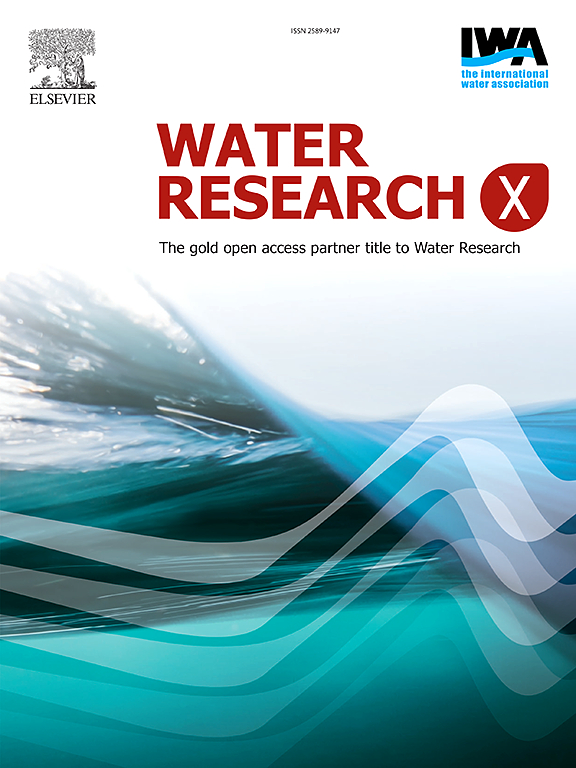由 Fe3O4 纳米粒子产生的被忽视的纳米流体效应可增强厌氧颗粒污泥中的传质效果
IF 7.2
2区 环境科学与生态学
Q1 ENGINEERING, ENVIRONMENTAL
引用次数: 0
摘要
磁铁矿(Fe3O4)颗粒被广泛报道用于提高厌氧颗粒污泥(AnGS)中的厌氧活性,但其基本机制仍不清楚。本研究表明,200 毫克 Fe3O4/L 剂量的 Fe3O4 微颗粒(MPs)和纳米颗粒(NPs)都能显著提高 AnGS 的特定厌氧活性(SAA)。 此外,参与厌氧过程的 hzs 和 hdh 基因的转录活性以及 AnGS 中的血红素 c 含量也明显提高。值得注意的是,Fe3O4 NPs 比 MPs 更有效地提高了 AnGS 中的anammox 活性。 从机理上讲,Fe3O4 MPs 释放出游离铁,anammox 细菌利用游离铁促进关键酶的合成,从而提高了其活性。与 MPs 相比,Fe3O4 NPs 不仅能将这些关键酶的合成提高到一个更高的水平,还能在 AnGS 表面产生纳米流体效应,改善底物的渗透性和粒内 Anammox 细菌的可及性。此外,纳米流体效应被确定为 Fe3O4 NPs 增强 AnGS 内 Anammox 活性的主要机制。 这些发现为纳米粒子对颗粒污泥系统的影响提供了新的见解,其影响范围超出了 AnGS。本文章由计算机程序翻译,如有差异,请以英文原文为准。

An overlooked nanofluids effect from Fe3O4 nanoparticles enhances mass transfer in anammox granular sludge
Magnetite (Fe3O4) particles have been widely reported to enhance the anammox's activity in anammox granular sludge (AnGS), yet the underlying mechanisms remain unclear. This study demonstrates that both Fe3O4 microparticles (MPs) and nanoparticles (NPs) at a dosage of 200 mg Fe3O4/L significantly increased the specific anammox activity (SAA) of AnGS. Additionally, the transcriptional activities of the hzs and hdh genes involved in the anammox process, as well as the heme c content in AnGS, were also notably enhanced. Notably, Fe3O4 NPs were more effective than MPs in boosting anammox activity within AnGS. Mechanistically, Fe3O4 MPs released free iron, which anammox bacteria utilized to promote the synthesis of key enzymes, thereby enhancing their activity. Compared to MPs, Fe3O4 NPs not only elevated the synthesis of these key enzymes to a higher level but also induced a nanofluids effect on the surface of AnGS, improving substrate permeability and accessibility to intragranular anammox bacteria. Moreover, the nanofluids effect was identified as the primary mechanism through which Fe3O4 NPs enhanced anammox activity within AnGS. These findings provide new insights into the effects of nanoparticles on granular sludge systems, extending beyond AnGS.
求助全文
通过发布文献求助,成功后即可免费获取论文全文。
去求助
来源期刊

Water Research X
Environmental Science-Water Science and Technology
CiteScore
12.30
自引率
1.30%
发文量
19
期刊介绍:
Water Research X is a sister journal of Water Research, which follows a Gold Open Access model. It focuses on publishing concise, letter-style research papers, visionary perspectives and editorials, as well as mini-reviews on emerging topics. The Journal invites contributions from researchers worldwide on various aspects of the science and technology related to the human impact on the water cycle, water quality, and its global management.
 求助内容:
求助内容: 应助结果提醒方式:
应助结果提醒方式:


